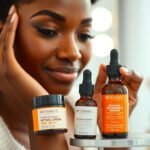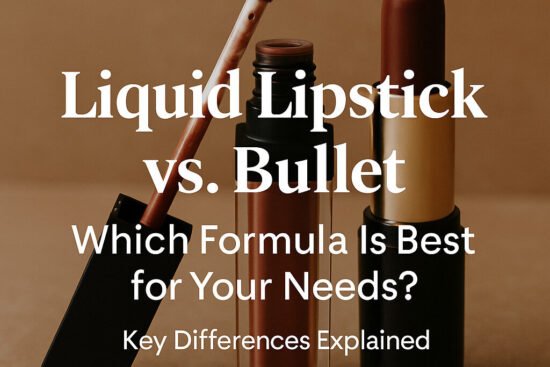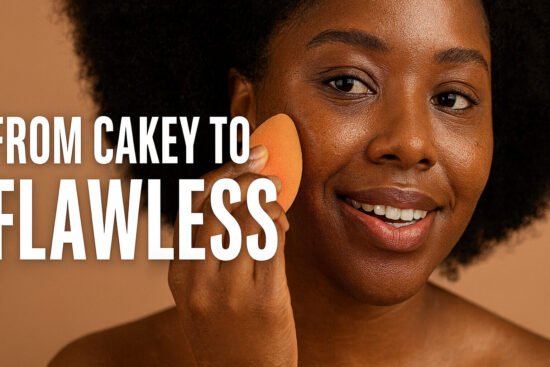
With a growing awareness of the need for sun protection, I want to share insights on why SPF is crucial for African American women. While melanin provides some natural protection against UV rays, it doesn’t make us immune to skin damage or the risk of skin cancer. I’ve researched and compiled effective SPF recommendations tailored to your unique skin needs, so you can confidently enjoy the outdoors while keeping your skin healthy and radiant. Let’s explore how to safeguard your skin without compromising your natural beauty.
Key Takeaways:
- SPF is crucial for all skin types, including African American women, to prevent skin damage and photoaging.
- A broad-spectrum sunscreen with an SPF of at least 30 is recommended for daily use, regardless of skin tone.
- Reapplication of sunscreen every two hours is important, especially after swimming or sweating.
- Some shades of darker skin can still experience sunburn and other UV-related issues, making protection necessary.
- Using sunscreen can help reduce the risk of skin cancers, such as melanoma, which may be less visible on darker skin tones.
- Incorporating sunscreens with additional skin-benefiting ingredients, like antioxidants, can enhance skin health.
- Consider using makeup products that contain SPF for additional coverage during daily wear.
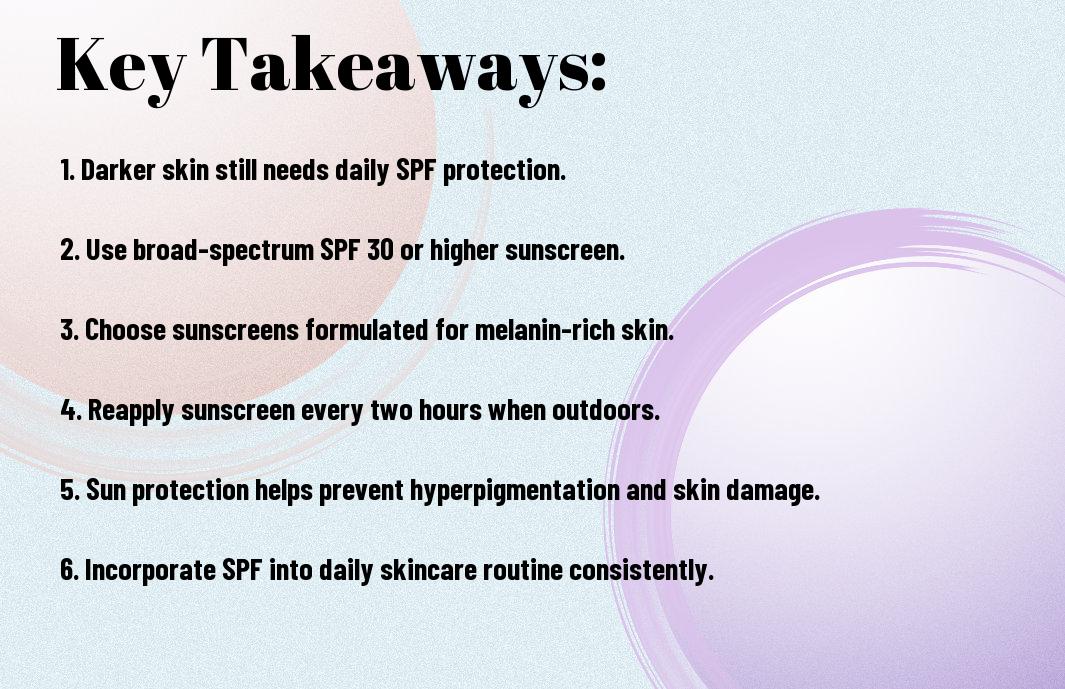
The Myths and Realities of SPF for Dark Skin
Debunking Common Misconceptions
Many people believe that dark skin doesn’t require sunscreen due to its natural melanin content. However, this notion is misleading. Although melanin does offer some protection against UV rays, it is not impervious. Studies indicate that those with darker skin types are still susceptible to skin damage, including sunburn and skin cancer. I often hear about individuals assuming they’re immune to the effects of the sun, which can lead to serious repercussions if precaution isn’t taken.
Understanding UV Protection in Melanin-Rich Skin
Mere melanin levels do provide a degree of sun protection, equivalent to an approximate SPF of 13, but that is still significantly lower than the recommended SPF for extended sun exposure. This limited natural defense means that dark skin, while less prone to immediate sunburn, still experiences long-term *skin damage*. For example, prolonged exposure can lead to conditions like *hyperpigmentation* or *photoaging*, which can compromise the skin’s health over time.
Moreover, it’s vital to acknowledge that UV rays penetrate deeper layers of the skin, resulting in damage that isn’t visible at first glance. This means that, unlike lighter skin tones, those with darker skin tones might not notice immediate reactions to sun exposure, often leading them to underestimate risk levels. In addition, darker skin may show signs of sun damage in different ways, like uneven skin tone or dark spots, which can affect your overall complexion. Incorporating a broad-spectrum sunscreen with an SPF of 30 or higher into your daily skincare routine plays a pivotal role in safeguarding your skin against these potentially harmful effects.
The SPF Spectrum: What Numbers Really Mean
Breaking Down SPF Ratings
SPF, or Sun Protection Factor, indicates a sunscreen’s effectiveness in blocking UVB rays, which are responsible for sunburn and can lead to skin cancer. The numbers on sunscreen labels are not linear; for instance, SPF 15 blocks about 93% of UVB rays, while SPF 30 offers around 97% protection. Yet, no sunscreen can provide 100% protection. I find it fascinating how many people believe that a higher SPF translates to a significantly better shield, without realizing the minimal difference between that and a lower SPF level.
The Importance of Broad-Spectrum Protection
Opting for a broad-spectrum sunscreen is vital in safeguarding your skin from both UVB and UVA rays. While UVB rays primarily cause sunburn, UVA rays penetrate deeper into the skin and contribute to aging and skin cancer. Choosing a product labeled as broad-spectrum ensures comprehensive defense against these harmful rays. I often assess a brand’s ingredients, ensuring it explicitly states coverage for both UVA and UVB.
Incorporating broad-spectrum protection provides peace of mind while enjoying the outdoors. UVA rays can penetrate through clouds and glass, affecting your skin even on overcast days or while sitting indoors. I’ve learned that many people underestimate their exposure, yet it can lead to long-term skin damage. Using a broad-spectrum sunscreen with a minimum of SPF 30, even on days with limited sun, significantly reduces the chances of skin issues over time. Balancing adequate sun protection is key, and I strive to make it a daily habit.
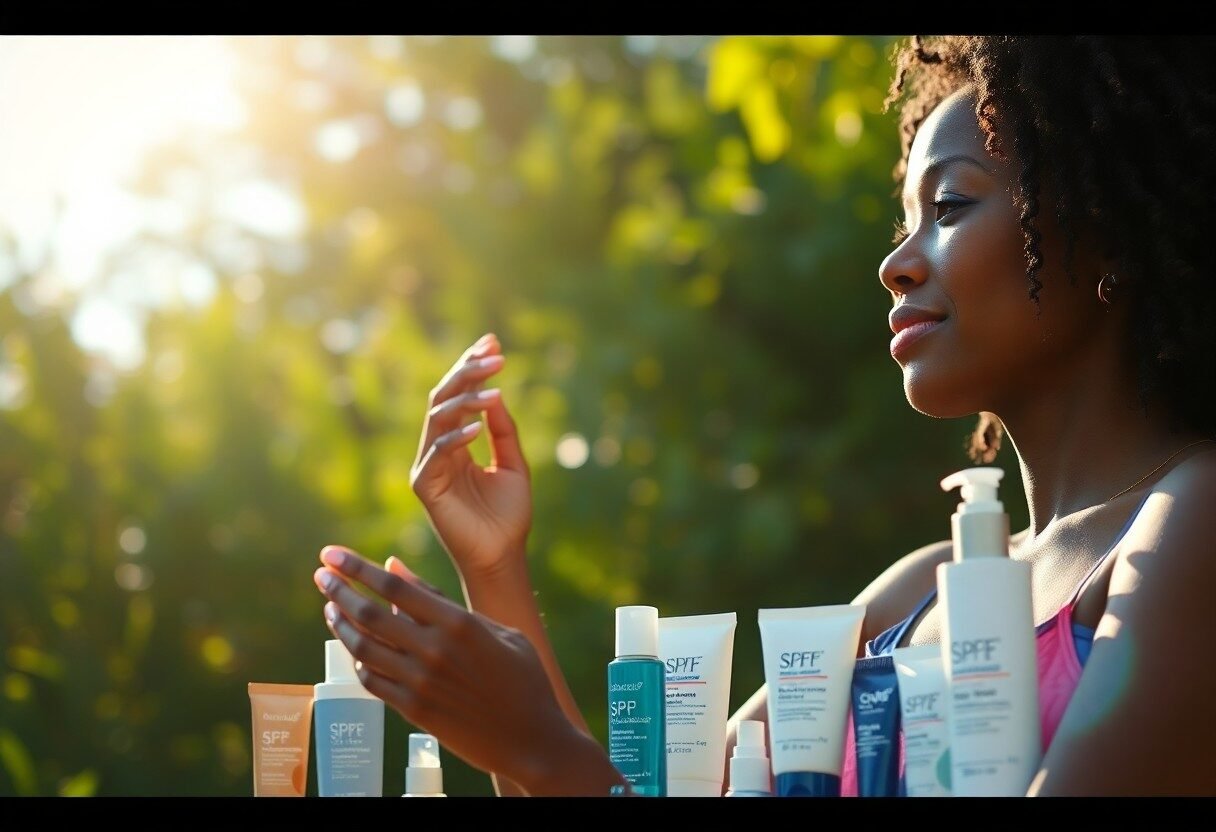
Choosing the Right Sunscreen: Ingredients Matter
Chemical vs. Physical Sunscreens
Chemical sunscreens absorb UV rays through their chemical filters, such as avobenzone and octisalate, offering a lightweight feel on the skin. In contrast, physical sunscreens use mineral ingredients like zinc oxide and titanium dioxide to reflect UV rays. For many, physical sunscreens are often preferred as they are less likely to irritate sensitive skin, and they work immediately upon application, making them a convenient choice for daily use.
Best Ingredients for Melanin-Rich Skin
For melanin-rich skin, look for sunscreens that include zinc oxide and titanium dioxide, as these physical blockers provide broad-spectrum protection without leaving a white cast. Additionally, formulations with niacinamide not only protect from UV rays but also help in reducing dark spots and enhancing skin texture, targeting common concerns faced by women of color.
Incorporating extra beneficial ingredients can enhance the effectiveness of your sunscreen. For melanated skin, vitamin E and green tea extract can offer antioxidant protection, which helps in fighting free radicals triggered by sun exposure. Check labels for broad-spectrum SPF 30 or higher, with added hyaluronic acid for hydration. When your sunscreen works double duty to protect and nourish, you’re more likely to enjoy the outdoors while keeping your skin healthy and radiant.
Customizing Your Sun Protection Routine
How to Incorporate SPF into Daily Skincare
Integrating SPF into your daily skincare is straightforward and effective. I recommend using a moisturizer or foundation that includes SPF 30 or higher as the final step in your morning routine. Look for formulas that offer broad-spectrum protection and are designed for your skin type. This simple addition ensures you’re providing your skin with necessary protection against harmful UV rays without adding extra steps to your regimen.
SPF Strategies for Different Activities: Outdoor vs. Indoor
Your SPF needs vary based on your daily activities. For outdoor activities, choose a water-resistant sunscreen with at least SPF 30 and reapply every two hours. Even during indoor activities, UV rays can penetrate windows, necessitating a lighter, daily SPF moisturizer to keep your skin protected. Do not forget, no matter where you are, giving your skin this protection is always a priority.
Engaging in outdoor activities increases your UV exposure significantly, making high-SPF products necessary for those days. For short errands or indoor settings, a broad-spectrum SPF 15 to 20 may suffice, but it’s wise to remain consistent with your use of sunscreen. I often remind myself to maintain that protective barrier even in shaded or cloudy areas, as up to 80% of UV rays can reach your skin. By customizing your SPF and being mindful of your environment, I ensure my skin stays protected year-round.
The Impact of Climate on Skin Health
Sun Protection in Various Climates
Living in different climates greatly influences your skin’s needs for sun protection. In tropical regions, where UV radiation levels are high year-round, daily application of broad-spectrum SPF 30 or higher is imperative. Conversely, arid climates might have less humidity but expose skin to intense sun, which also necessitates reliable sunscreen usage. Coastal areas can present a unique challenge as reflected sunlight from water and sand increases UV exposure. Evaluating the climate around you helps tailor your sun protection routine effectively.
Seasonal Considerations for SPF Application
The changing seasons bring shifts in sun intensity and, consequently, the way you should approach SPF application. In summer, UV rays are at their peak, making it imperative to apply sunscreen regularly, even on cloudy days. During winter, snow can reflect up to 80% of UV rays, putting you at risk for sun damage, especially if you enjoy outdoor activities. Spring and fall still warrant diligent SPF usage, as UV rays can penetrate through cloud cover and remain strong.
Understanding seasonal variations can enhance your skin protection. I often find myself using a thicker sunscreen during summer, especially for outdoor outings, while opting for lighter formulations in the milder climates of spring and fall. In winter, I focus on hydrating formulas that also offer UV protection, often layering them beneath a physical barrier like a scarf or hat when outdoors. Adjusting my SPF game according to the season ensures my skin is well-protected against unexpected sun exposure.

Coping with Common Skin Issues: Dark Spots and Hyperpigmentation
The Relationship Between UV Exposure and Hyperpigmentation
UV exposure significantly contributes to the formation of dark spots and hyperpigmentation, especially in darker skin tones. When your skin is exposed to sunlight, UV rays stimulate melanocytes, the cells responsible for melanin production. This can lead to an increase in pigmentation, resulting in uneven skin tone and dark patches, particularly if proper sun protection isn’t used consistently. Understanding this connection is imperative for managing and preventing hyperpigmentation.
Long-Term Skin Care Tips for Prevention
Implementing a consistent skincare routine can greatly reduce the risk of hyperpigmentation over time. Regular use of a broad-spectrum SPF helps shield your skin from harmful rays, while incorporating antioxidants can protect against oxidative stress. Additionally, using products containing vitamin C and niacinamide can brighten your complexion and even out skin tone. This comprehensive approach aligns your skincare with your wellness goals.
- Consistently apply a broad-spectrum SPF of at least 30.
- Incorporate antioxidants into your skincare routine.
- Utilize products with vitamin C for brightening.
- Consider using niacinamide to even out skin tone.
Staying proactive about your skincare can prevent the worsening of dark spots. I recommend using gentle exfoliants, like alpha-hydroxy acids (AHAs), to encourage cell turnover and fade existing imperfections. Also, drinking plenty of water and maintaining a healthy diet rich in vitamins can promote glowing skin from the inside out. This holistic approach supports long-term skin health.
- Use gentle exfoliants like AHAs for cell turnover.
- Stay hydrated by drinking plenty of water.
- Incorporate a diet rich in vitamins.
Staying Informed: Resources for SPF Education
Trustworthy Organizations and Websites
Organizations like the American Academy of Dermatology and the Skin Cancer Foundation provide extensive resources on SPF education. Their websites frequently offer articles and guidelines on properly selecting and using sunscreen. These organizations are dedicated to promoting skin health, making them reliable sources. Additionally, the Centers for Disease Control and Prevention (CDC) offers valuable insights into sun safety and skin cancer prevention, tailored for diverse populations.
Engaging with Dermatology Professionals
Building a relationship with dermatology professionals can enhance your understanding of sun protection tailored to your unique skin type. Regular consultations allow you to discuss any concerns while acquiring personalized recommendations regarding SPF products. If you’re unsure about what products to use or have specific skin conditions, dermatologists can provide insights tailored to your needs. They are invaluable resources for proper SPF application techniques, skin assessments, and advanced treatments to maintain healthy skin, especially in relation to sun exposure and its effects.
Real-Life Application: Testimonials from African American Women
Personal Experiences with SPF Use
Hearing directly from those who’ve embraced SPF in their daily routines has been enlightening. Many African American women share how they once believed their deeper skin tones provided enough protection against sun damage. However, a simple shift to incorporating SPF has led to positive changes in their skin health and appearance. Women express feeling more confident and radiant, with some noting reduced hyperpigmentation and even smoother skin texture over time.
Successful Strategies Shared by Community Members
Peer advice often reveals the most relatable solutions. Many community members emphasize the role of daily reminders in their SPF use. Some keep their sunscreen next to their toothbrush or in their car, ensuring they don’t forget before heading out. Additionally, sharing personal rituals, like applying SPF every morning as part of a self-care routine, helps reinforce the importance of sun protection.
Discussions around SPF have led to insightful strategies that truly resonate. One woman shared how she mixes her sunscreen with daily moisturizer to streamline her routine, both saving time and ensuring she doesn’t skip this vital step. Many also advocate for using products specifically formulated for darker skin tones, which often avoids the chalky residue common in traditional sunscreens. By pooling these specific tips and tactics, women in the community are crafting tailored approaches that not only protect their skin but also empower them to advocate for broader awareness around the importance of SPF among African American women.
Summing up
To wrap up, protecting your skin is necessary, regardless of your skin tone. As an African American woman, I understand the unique challenges we face in skincare. I encourage you to choose broad-spectrum SPF 30 or higher to shield your skin from harmful UV rays. Regular application, no matter the season, will help maintain your skin’s health and appearance. Being vigilant about sun protection is a powerful step in enhancing your skincare routine, allowing you to confidently embrace your beautiful complexion.
FAQ
Q: Why is SPF important for African American women?
A: SPF (Sun Protection Factor) is vital for everyone, including African American women. Although darker skin tones have more melanin, which provides some natural protection against sunburn, they are still susceptible to UV damage. Using SPF helps prevent skin issues such as hyperpigmentation, premature aging, and skin cancer.
Q: What SPF level should African American women use?
A: It is recommended that African American women use a broad-spectrum SPF of at least 30. This level provides adequate protection against both UVA and UVB rays. For extended outdoor activities, a higher SPF of 50 or more is advisable.
Q: How often should I reapply my sunscreen?
A: Sunscreen should be reapplied every two hours, especially after swimming, sweating, or towel drying. If you’re using a water-resistant formula, check the product instructions for specific reapplication guidelines to ensure you maintain effective protection.
Q: Can I use makeup with SPF instead of sunscreen?
A: While makeup with SPF can provide some protection, it is not a substitute for a dedicated sunscreen. Makeup may not always offer adequate coverage or the necessary SPF level. It’s best to apply sunscreen first and then layer your makeup on top for optimal protection.
Q: What type of sunscreen is best for darker skin tones?
A: Broad-spectrum physical sunscreens that contain zinc oxide or titanium dioxide are excellent choices for darker skin tones. They provide effective protection without leaving a white cast. Look for formulations that are non-greasy and suitable for daily wear.
Q: Is sunscreen necessary on cloudy or rainy days?
A: Yes, UV rays can penetrate clouds and still cause skin damage even on overcast days. It’s important to apply sunscreen daily regardless of the weather conditions to protect your skin from harmful UV exposure.
Q: Are there any additional skincare tips for African American women related to sun exposure?
A: Along with using SPF, African American women should consider including antioxidants like vitamins C and E in their skincare routine. These can help combat free radical damage caused by UV exposure. Additionally, keeping the skin moisturized can enhance its resilience against sun damage.





